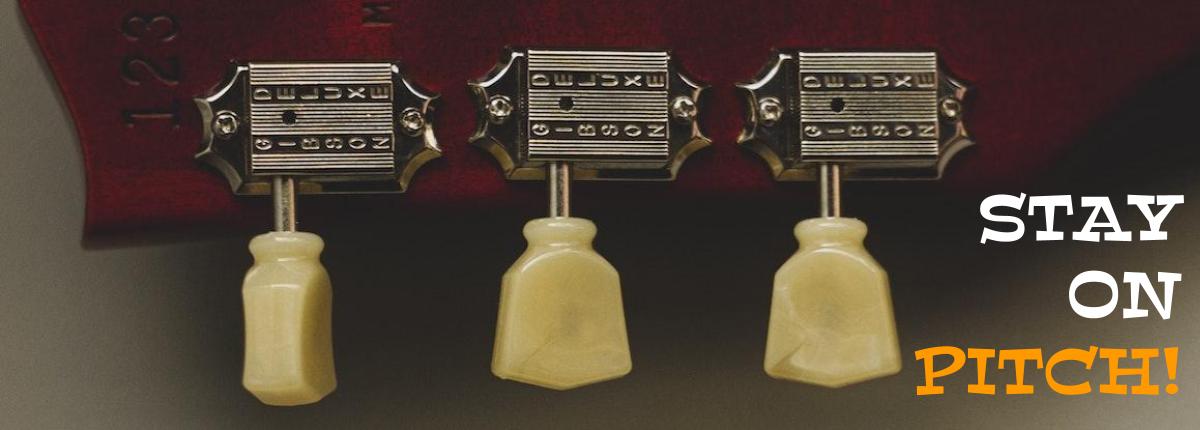
By Tyler Connaghan
Posted 10/11/2022
We’ve all been there. You pick up your favorite guitar, you get ready to start playing, and then *bleh*…
It’s wildly out of tune.
In spite of everything you do, you just can’t get it to stay in tune. Unfortunately, this is something that can affect just about any guitar regardless of style, construction, or cost.
The main questions: how do we go about fixing a guitar that won’t stay in tune and how do we prevent it from going out of tune again?
Let’s dig in and see if we can find the answers.
Why Won’t My Guitar Stay In Tune?
There are a few different reasons why a guitar might not stay in tune, though the first thing you need to decipher is whether your guitar is either playing out of tune or coming out of tune.
Having a guitar that continuously slips out of tune is different from one that won’t tune up.
If your guitar won’t play in tune, it’s most likely intonation.
1. Intonation
Intonation, in the guitar world, is the accuracy of pitch in playing a note on a string.
We measure intonation from the nut to the bridge saddle. The 12th fret should be where the middle of the string lies, meaning that note should be exactly the same note as the open note of that particular string.
If you play chords on your guitar that combine open notes and fretted notes up higher on the neck, you’ll notice intonation problems a lot more. Guitars that are not appropriately intonated won’t ever sound in tune, and the 12th fret notes will sound flat or sharp compared to their open-string octave counterparts.
You can solve many intonation problems by tweaking the truss rod, which sits down the center of the neck. If you’ve never adjusted a truss rod before, we highly recommend taking it to a local guitar tech to show you how to do it properly.
2. The Nut
Your nut sits at the top of your fretboard and is an essential component when it comes to tuning. If the nut doesn’t seat the strings correctly, your guitar won’t play in tune. A nut that is cut too narrow will pinch the strings when you tune them. It will seem as if nothing is happening while you tune, then suddenly you’ll hear a pop and the tuning will change drastically. Essentially, your string is getting caught, and you need to widen your nut slots.
On the other hand, if your nut isn’t too narrow, though the string is getting caught due to a rough edge, you might just be able to smooth it over with a bit of pencil graphite.
Again, if you’ve never done any of this on your own, we recommend taking it to a guitar tech.
3.The Strings
If your guitar isn’t out of tune all the time, though slipping out of tune often, the problem might be your strings. As guitar strings begin to reach the end of their lifespan, they’ll feel brittle and difficult to fret. Let it go too long, and fretted notes will start sounding sharp, especially as you play higher up on the neck. Beyond that, old strings lead to a dull sound, lack of sustain, and a grimy appearance.
Make sure that you’re changing your strings regularly and take a minute to stretch them before putting them on, as they’ll last a lot longer and stay in tune right off the bt. By stretching your strings, you can bypass the period where they stretch themselves once strung and continuously go flat.
4. Low-Quality Machine Heads
Unfortunately, if your guitar was cheaply made, there is a good chance that it won’t have quality machine heads. Low-quality machine heads typically fail to lock in place, meaning they will slip out of place quickly, causing your guitar to fall out of tune. You can usually tell this is an issue if you tune your guitar up and see your pegs move.
The best way to remedy this is to simply install new machine heads. I’m a huge fan of locking tuners and highly recommend the locking tuners from Fender for those who want high-quality machine heads without spending a ton of money.
5. You
The most important determining factor for staying in tune is the Player. Depending on how you play, the touch of your fretting hand can be a significant factor in tuning problems.
When I first started recording my guitar, I began to look at the way I played under a microscope. It wasn’t until then that I realized I played with a fairly heavy hand. In many cases, my heavy hand resulted in some pretty terrible recordings. It was an aspect of my playing that I needed to triage fast.
If you don’t know what I’m talking about, pick up your guitar and play a G barre chord. Notice the harder you press down, the more out of tune your chord becomes. This has nothing to do with bending notes but rather pressing too hard into the neck.
Try a lighter touch (with less attack?) and I guarantee you’ll see results.
The Journey to Perfect Tune
Of course, there is no such thing as a “perfectly intonated” guitar. Chords will never sound 100% perfect, as guitars aren’t made to sound perfect. The goal is to get your tuning and intonation as close to perfect as possible. That little waiver that might happen from time to time when you play different chords is entirely natural. Learn to accept it, and you’ll have a whole lot more fun playing your instrument.
If your problem is a bit more severe than the slight out-of-tune characteristic of a natural guitar, you may need to check your playing style or perform a bit of maintenance.
If all else fails, visit your local tech, as they’ll be able to pinpoint your problem with ease so that you can get back to shredding.
